On 1st November 2024, the canopy of Novi Sad railway station collapsed, killing 15 people and severely injuring two others. What began as a tragedy quickly transformed into one of the largest protest movements in Serbia's recent history, drawing comparisons to the student protests of 1968 according to Slovenian philosopher Slavoj Žižek.
The Spark That Ignited a Nation
The railway station collapse immediately raised questions about infrastructure safety and maintenance across Serbia. But public frustration grew exponentially when evidence emerged that government officials, including Construction Minister Goran Vesić, had initially denied the canopy was ever reconstructed—despite readily available news articles and videos showing Vesić himself opening the reconstructed station.
When faced with mounting evidence, Vesić announced his resignation but pointedly stated he "does not feel responsible." This apparent lack of accountability catalysed what would become a nationwide protest movement.
Serbia: A Historical and Geographical Backdrop
Serbia is a landlocked country situated in the central Balkans, at the crossroads between Eastern and Western Europe. Bordered by Hungary to the north, Romania and Bulgaria to the east, North Macedonia to the south, and Croatia, Bosnia and Herzegovina, and Montenegro to the west, Serbia occupies a strategically important position in Southeastern Europe.
With a population of approximately 7 million people, Serbia's capital and largest city is Belgrade, which sits at the confluence of the Danube and Sava rivers. The country's second-largest city, Novi Sad—where these protests began—is located in the northern province of Vojvodina.
Serbia's history is rich and complex, dating back to medieval times when it was a powerful empire under the Nemanjić dynasty in the 12th-14th centuries. After falling to Ottoman rule for nearly five centuries, Serbia gradually gained independence in the 19th century, becoming a kingdom in 1882.
The 20th century brought tremendous change and upheaval. After World War I, Serbia became the core of the newly formed Kingdom of Yugoslavia. Following World War II, Yugoslavia was reconstituted as a socialist federal republic under Josip Broz Tito, who maintained a unique position as a non-aligned state during the Cold War.
The death of Tito in 1980 and the fall of communism across Eastern Europe led to Yugoslavia's violent dissolution in the 1990s. Serbia was at the centre of the Yugoslav Wars, which brought international sanctions, NATO bombing in 1999, and significant political isolation.
Following the overthrow of Slobodan Milošević in October 2000 (in what became known as the Bulldozer Revolution), Serbia embarked on a path of democratic transition and European integration. However, this journey has been complicated by persistent challenges related to corruption, political freedoms, and the rule of law.
Post-Transition Disillusionment
After the fall of Milošević in 2000, many Serbians hoped for genuine democratic reform and economic prosperity. However, the transition has been marked by persistent corruption, state capture by political elites, and economic inequality. Despite EU candidacy status, many citizens feel the promised benefits of European integration remain elusive while a small elite continues to prosper.
Media Freedom and Democratic Backsliding
Serbia has experienced concerning democratic regression in recent years. The 2022 Freedom House report downgraded Serbia from "partly free" to "hybrid regime," citing deteriorating media freedom, electoral irregularities, and increasingly concentrated executive power. Many independent media outlets have been purchased by government-friendly business interests, while critical journalists face intimidation and smear campaigns.
The Kosovo Question and Nationalist Politics
The unresolved status of Kosovo remains a deeply divisive issue that successive governments have leveraged for political advantage. The SNS has maintained an ambiguous position—rhetorically defending Serbian claims to Kosovo while pragmatically engaging in EU-mediated negotiations. This approach has allowed the party to retain nationalist credentials while avoiding diplomatic isolation, but many citizens view it as manipulative political theater that distracts from domestic governance failures.
Economic Grievances
Despite modest GDP growth in recent years, economic benefits have been unevenly distributed. Youth unemployment remains high, prompting significant emigration of educated young people. Meanwhile, foreign investments touted by the government often come with questionable environmental standards and labor practices, as exemplified by controversies surrounding Chinese-funded projects like the Rio Tinto lithium mine.
The Unresolved Legacy of the 1990s
Serbia's complicated relationship with its recent past continues to influence contemporary politics. While significant strides have been made in international cooperation, including the arrest and transfer of war crimes suspects to The Hague, domestic reckoning with the Yugoslav Wars remains politically contentious. This has created a situation where historical narratives are often manipulated for political purposes, impeding genuine societal reconciliation.
Institutional Weakness
Perhaps most relevant to the current protests is the perception that key institutions meant to check power—courts, regulatory bodies, anti-corruption agencies—have been systematically weakened or captured by ruling party interests. The inability of these institutions to hold powerful figures accountable creates precisely the conditions where a preventable tragedy like the railway station collapse becomes not just possible but probable.
Since 2012, the political landscape has been dominated by the Serbian Progressive Party (SNS) led by Aleksandar Vučić, who has served as Prime Minister (2014-2017) and later as President (2017-present). Throughout this period, Serbia has maintained a delicate balancing act between aspirations for EU membership and traditional ties with Russia and China.
From Silent Vigils to Mass Demonstrations
The protests began as quiet vigils for victims but quickly evolved. By 22nd November, students and professors from the Faculty of Dramatic Arts in Belgrade were attacked by an organised group while paying homage to the victims, with some attackers allegedly being high-ranking officials of the ruling Serbian Progressive Party (SNS).
In response, students began occupying university facilities across the country. The movement adopted the powerful symbol of 15 minutes of silence—from 11:52 am (the time of the collapse) to 12:07 pm—to commemorate each life lost.
The scale of demonstrations grew rapidly. By December 2024, more than 50 university campuses had suspended classes due to student protests. By March 2025, the protests had spread to 400 cities and towns throughout Serbia.
Government Response: Deflection and Division
President Aleksandar Vučić and government-affiliated media outlets attempted to delegitimise the protests through various means:
Claiming Western countries were funding demonstrators to destabilise Serbia
Accusing Croatian students visiting Belgrade of working for Croatian intelligence
Labelling protesters as "anarcho-terrorists" and "social scum"
Comparing protesters to "sediment and filth which occasionally rises to the surface"
Claiming a "colour revolution" was being attempted
Perhaps most alarmingly, Vučić stated in December that "if [he] wished so, [he] could send out the Cobras special forces on the students and they would throw them around in 6-7 seconds."
Violence Against Peaceful Protesters
Throughout the protests, demonstrators faced concerning levels of violence:
Multiple incidents of vehicles deliberately driving through crowds during road blockades
Organised attacks against students at university facilities
The deployment of teargas and mass arrests
In January 2025, four attackers with baseball bats stormed from SNS offices in Novi Sad, seriously injuring a female student and breaking her jaw
These incidents only strengthened resolve and expanded participation in the protests, with farmers, doctors, lawyers, and other professionals joining the movement in solidarity.
Key Demands and Public Support
The protesters' demands remained clear and consistent:
Publication of all documentation regarding the railway station reconstruction
Dismissal of charges against arrested protesters
Criminal charges against those who attacked students and citizens
A 20% increase in university budgets
By February 2025, polling showed approximately 80% of Serbian citizens supported the majority of these demands, with 64% supporting the protests themselves.
Historic Moments of Solidarity
The protests inspired remarkable acts of solidarity:
Hundreds of farmers mobilised tractors to shield protesting students from attacks
Over 650 bikers from different clubs gathered to protect students
Taxi drivers organised free transportation for students attending protests
Medical workers joined blockades despite risks to their employment
Seven archbishops of the Serbian Orthodox Church signed an open letter supporting the students
Recent Developments and Future Implications
The protests have forced notable concessions. The Government of Serbia adopted a decision providing £86 million for higher education, effectively meeting the fourth demand by increasing the education budget by 20%.
However, tensions remain high. Education workers who participated in strikes have seen their salaries slashed by 50-100%, sometimes receiving as little as 2,191 RSD (less than €20). This punitive measure sparked widespread outrage and solidarity networks to support affected teachers.
The movement continues to grow, with major demonstrations scheduled for March 2025 in Belgrade. President Vučić has responded with concerning rhetoric, threatening that "everyone who participates in it will be arrested" and suggesting that implementing a state of emergency "is one of the options."
A Nation at a Crossroads
These protests represent more than just a reaction to a tragic accident—they embody a fundamental struggle for accountability in Serbian governance. With widespread support across all segments of society, including students, professionals, farmers, and religious leaders, the movement has exposed deep fissures in Serbia's political landscape.
As tensions continue to escalate, Serbia finds itself at a crucial juncture in its democratic development. The coming weeks will likely prove decisive in determining whether this grassroots movement can achieve lasting institutional reform or whether the government will resort to more authoritarian measures to maintain control.
The railway station canopy collapse has transformed from a tragedy into a powerful symbol of governmental negligence—and the student-led response has evolved into one of the most significant protest movements in modern Serbian history.
Serbia's Democratic Journey: A Complicated Path
An important context for understanding today's protests is Serbia's complex relationship with democratic governance. The country has never experienced a prolonged period of stable, liberal democracy in its modern history. After centuries under Ottoman and Habsburg rule, Serbia's brief periods of independence were marked by constitutional monarchies with limited democratic features, followed by royal dictatorship in the interwar period.
The socialist Yugoslavia era (1945-1991) operated under a one-party system that, while more liberal than other Eastern Bloc countries, was not democratic in the Western sense. Following Yugoslavia's collapse, the Milošević era (1989-2000) featured formal democratic institutions but functioned as a competitive authoritarian regime with rigged elections, controlled media, and persecution of opposition.
The overthrow of Milošević in 2000 represented Serbia's most promising democratic moment—a peaceful transfer of power following citizen protests. The decade that followed saw meaningful democratic reforms, increased media freedom, and steps toward EU integration. However, this democratic transition remained incomplete, with institutions lacking deep roots and old power networks adapting rather than disappearing.
Since the SNS came to power in 2012, Serbia has experienced what political scientists term "democratic backsliding"—the gradual erosion of democratic norms and institutions by elected leaders. This regression has occurred through legal means that maintain a democratic façade while undermining substantive democratic governance.
Why Democracy Matters for Serbia
The question of why democracy matters for Serbia operates on several levels:
Regional Stability: The Western Balkans' history demonstrates how authoritarian governance can exacerbate ethnic tensions and potentially lead to conflict. Democratic institutions provide peaceful mechanisms for resolving societal divisions without resorting to violence.
Economic Development: Serbia's economic challenges—from corruption to uneven development—are directly linked to governance quality. Countries with stronger democratic institutions typically demonstrate better long-term economic performance through greater transparency, rule of law, and economic inclusivity.
European Integration: Despite complex feelings about the EU among Serbians, most citizens support eventual membership. Genuine democratic reform is a prerequisite for EU accession, making democratic backsliding not just a domestic concern but a barrier to Serbia's stated foreign policy goals.
Brain Drain: Serbia loses thousands of educated young people annually to emigration, partly due to limited economic opportunities but also due to perceptions of a system where connections matter more than merit. Democratic reforms addressing corruption and transparency potentially help retain talent essential for development.
Citizen Dignity: Perhaps most fundamentally, the current protests reflect a desire for basic dignity—for citizens to be treated not as subjects but as constituents to whom government is accountable. The railway station collapse epitomises a governance approach where citizen welfare is secondary to political expediency.
The protesters' demands thus reflect not abstract democratic ideals imported from abroad, but practical concerns about governance that affects daily life—from infrastructure safety to educational funding. The question is not whether Serbia should adopt a foreign model of governance, but whether its government will be accountable to its citizens and prioritise their wellbeing over maintaining political control.
The Global Significance: Grassroots Democracy in an Authoritarian Age
The Serbian protests hold profound significance beyond the country's borders, particularly at a time when democracy faces challenges worldwide. In an era marked by democratic backsliding and the rise of authoritarian tendencies across multiple continents, the Serbian movement offers several important lessons:
The Power of Organic Movements
Unlike many organised political campaigns, the Serbian protests emerged organically from a genuine public response to tragedy and government negligence. This grassroots development has granted the movement a moral authority and authenticity that traditional political opposition often struggles to achieve. By beginning with simple 15-minute silent vigils and gradually building momentum, the protesters demonstrated that powerful movements need not be orchestrated from above—they can emerge from sincere collective grief and anger.
Cross-Societal Solidarity
Perhaps most remarkable about these protests is how they've transcended traditional divides. University students, farmers with tractors, medical professionals, lawyers, Orthodox clergy, and citizens from all walks of life have found common cause. This cross-societal solidarity presents a template for effective resistance to authoritarianism—when movements bridge different segments of society, they become significantly more difficult to dismiss or suppress.
Accountability as the Foundation of Democracy
At their core, these protests speak to the most fundamental aspect of democratic governance: accountability. In demanding transparency regarding the railway station collapse and insisting that officials take responsibility for their actions, the protesters are reasserting the basic principle that those who govern must answer to those they govern. This principle crosses ideological lines and reminds us that functioning democracies require accountability mechanisms regardless of which party holds power.
Non-Violent Persistence in the Face of Intimidation
Despite facing physical attacks, vehicle assaults, arrest threats, salary reductions, and propaganda campaigns, the protesters have largely maintained non-violent discipline. This approach has maximised public support and prevented the government from justifying a harsher crackdown. The Serbian protesters' persistence through months of pressure offers a blueprint for movements elsewhere facing similar intimidation tactics.
The Digital Amplification of Local Actions
The protests have effectively leveraged social media to document events, coordinate actions, and counter government narratives. When students were attacked, when vehicles drove into crowds, when government officials made inflammatory remarks—all were captured, shared, and scrutinised. This digital amplification of local incidents has created a cycle of accountability that transcends traditional media controls.
In a world where democratic spaces are shrinking in many regions, the Serbian protests represent a compelling counter-narrative—demonstrating that genuine grassroots movements can still emerge, sustain themselves, and effectively challenge authority when conditions demand it. While the ultimate outcome remains uncertain, the movement has already succeeded in showing that even in challenging political environments, citizens maintain the capacity to organise, resist, and insist on the fundamental democratic principle that power must be accountable to the people it serves.
Whether this template can be replicated in other contexts facing democratic erosion remains to be seen. But the Serbian protests offer a powerful reminder that democracy is not merely a system of government—it is a constant practice of civic engagement that requires courage, solidarity, and persistence in the face of adversity.
Further reading
Lessons from History - What the West should remember about Yugoslavia
The 1990s are a decade of juxtaposition worldwide. In the US, President Clinton talked of ‘building a bridge to the 21st century,’ and there was optimism about the future. The end of the Cold War saw massive spending increases on domestic policies, and Tony Blair swept to power on a wave of hope.
☕ Love this content? Fuel our writing!
Buy us a coffee and join our caffeinated circle of supporters. Every bean counts!


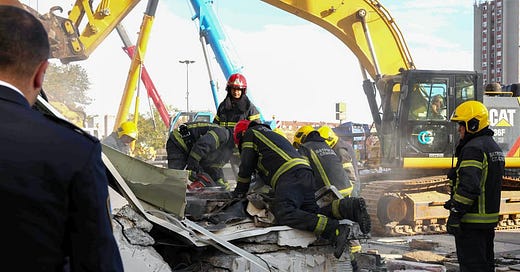




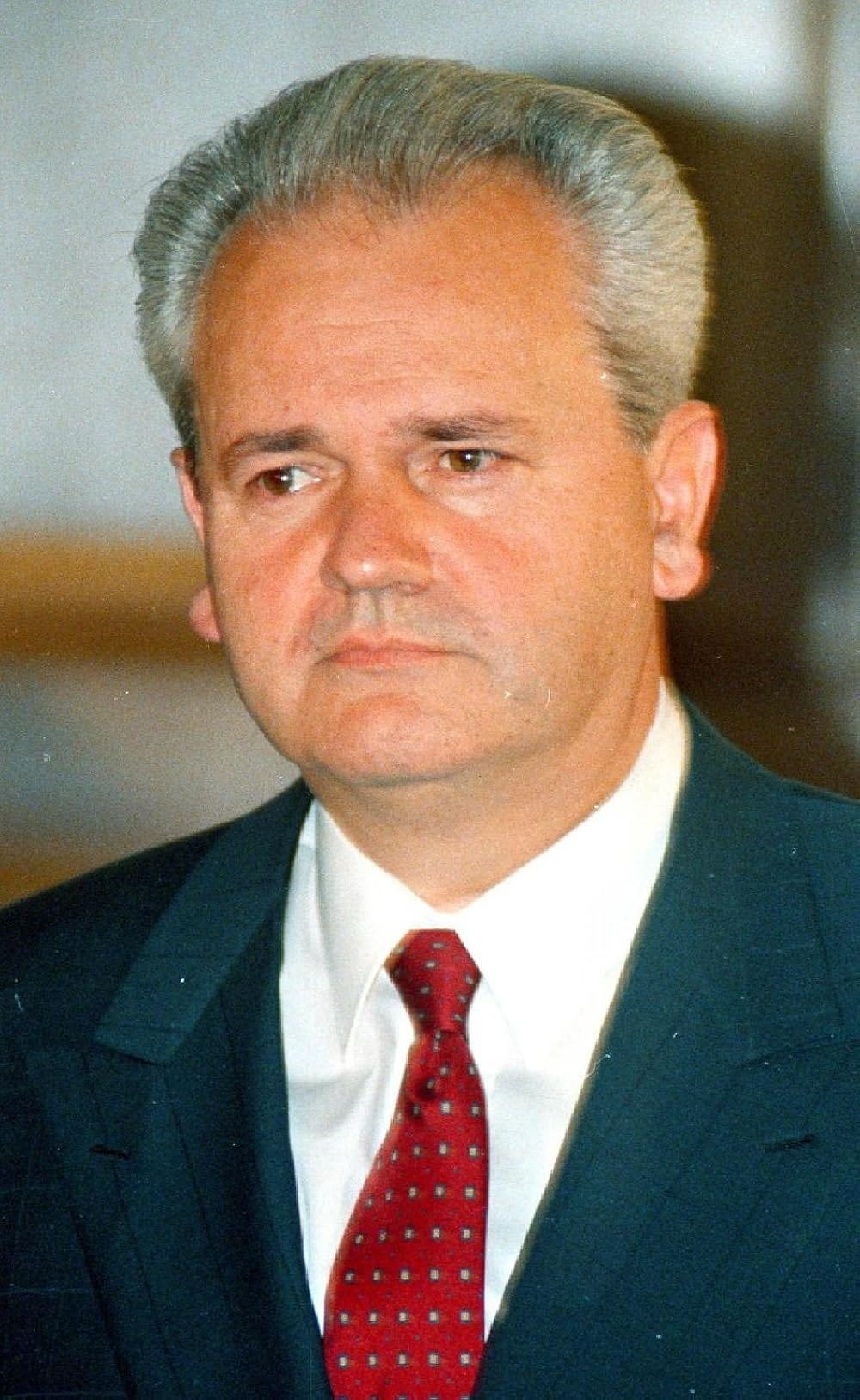
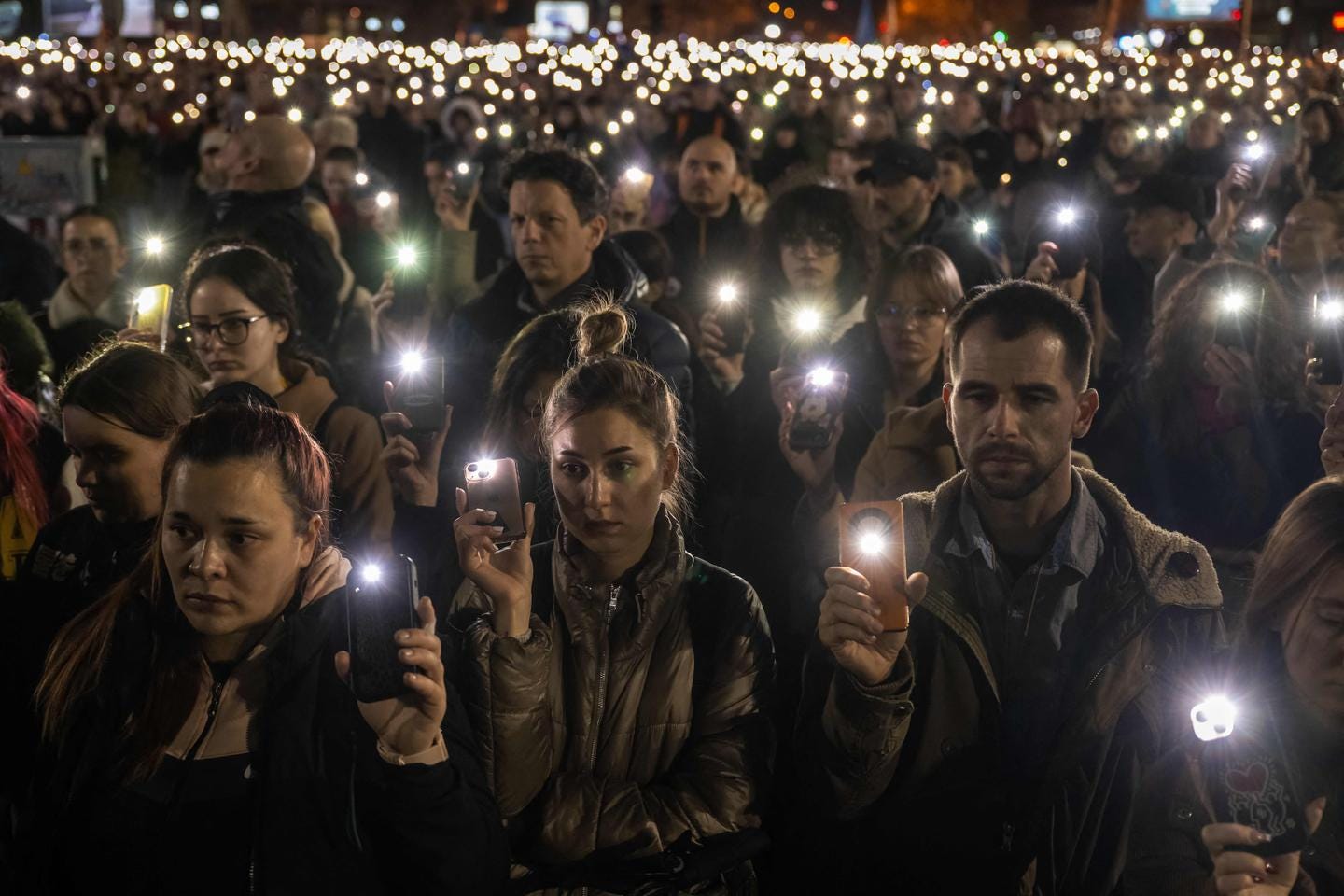
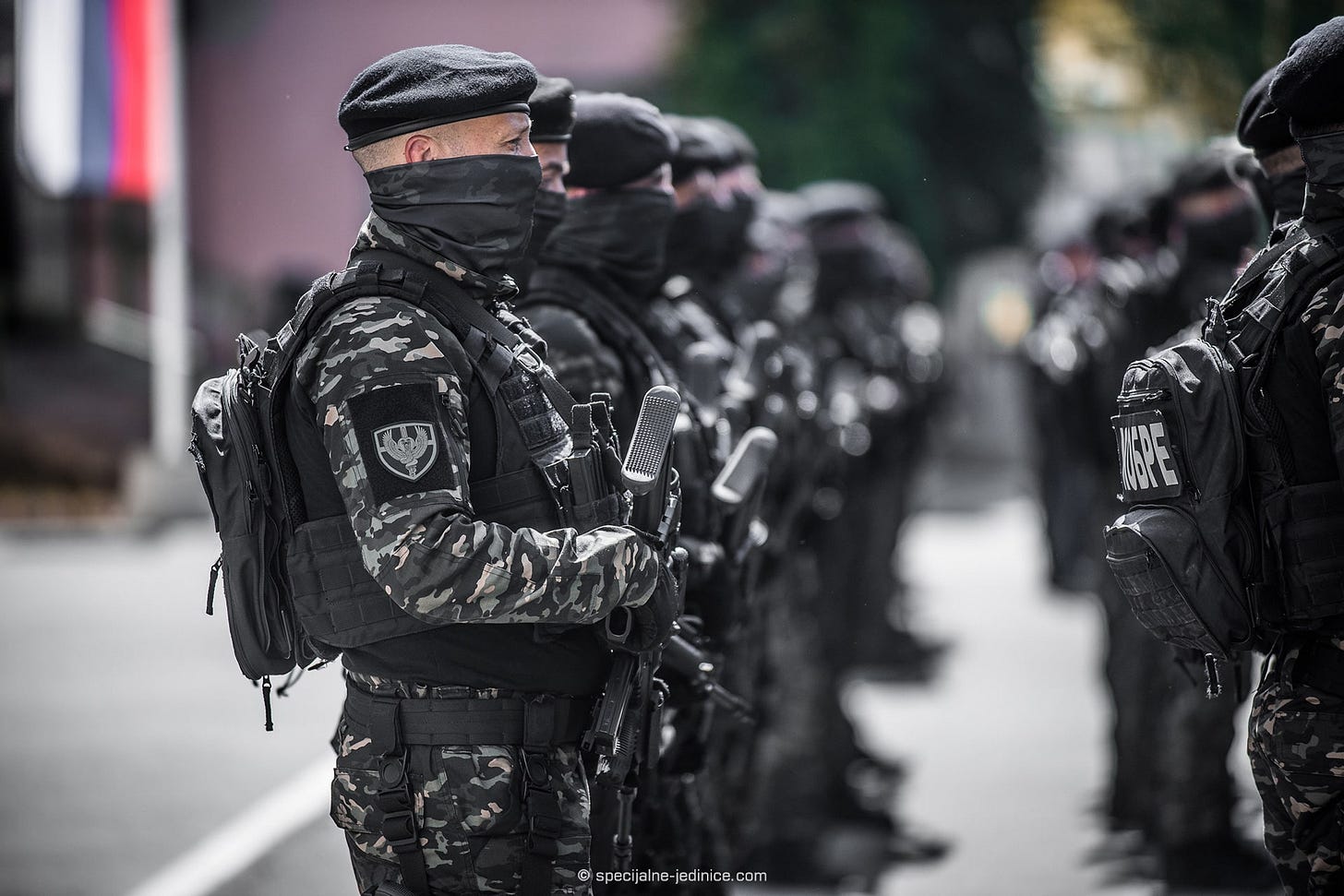
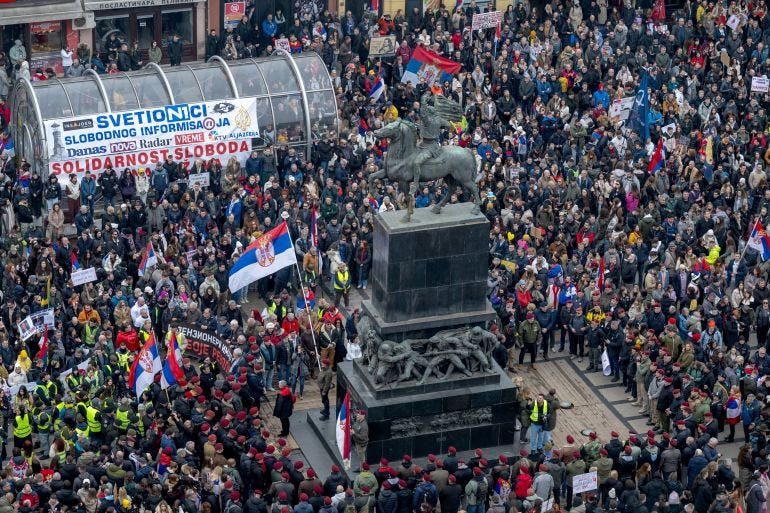
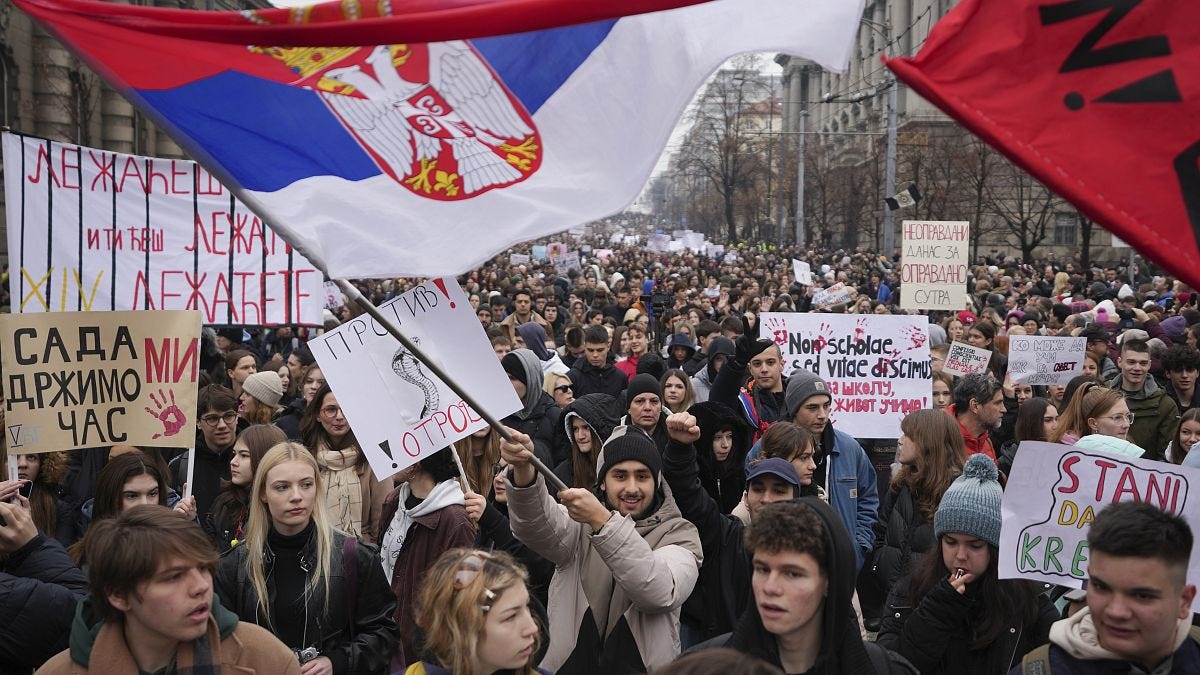
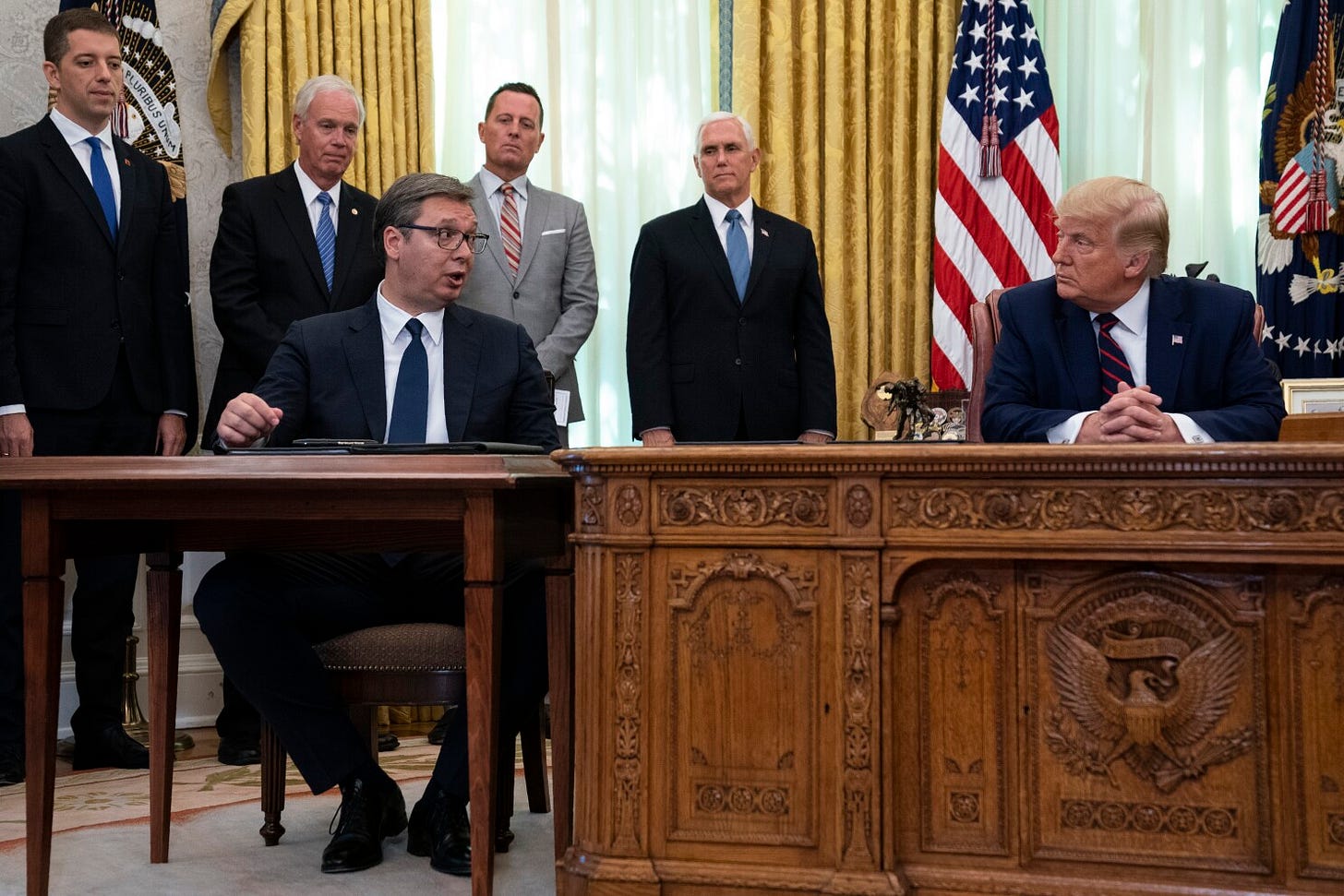

"The 1990s are a decade of juxtaposition worldwide. In the US, President Clinton talked of ‘building a bridge to the 21st century,’ and there was optimism about the future. The end of the Cold War saw massive spending increases on domestic policies, and Tony Blair swept to power on a wave of hope.
And yet, in some ways, the 1990s was the worst decade of …"
Very good essay, thank you! Sometimes, HOPE just feels like a mere fruitless trap...